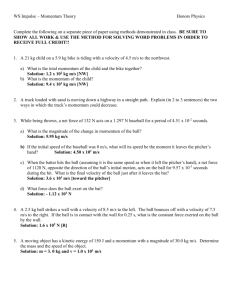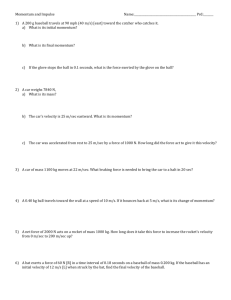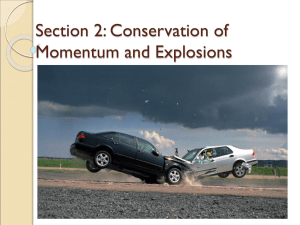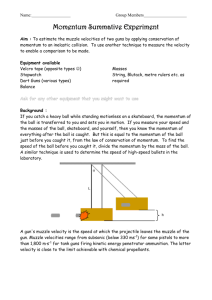Chapter 2 ClickerA Answers
advertisement
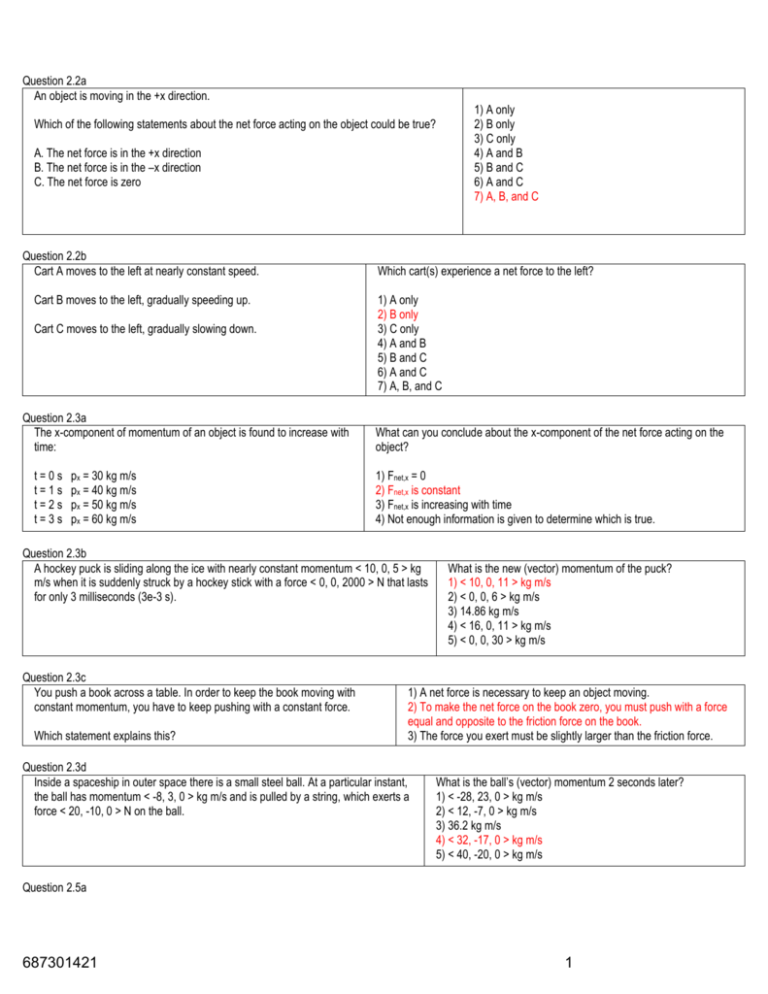
Question 2.2a An object is moving in the +x direction. 1) A only 2) B only 3) C only 4) A and B 5) B and C 6) A and C 7) A, B, and C Which of the following statements about the net force acting on the object could be true? A. The net force is in the +x direction B. The net force is in the –x direction C. The net force is zero Question 2.2b Cart A moves to the left at nearly constant speed. Cart B moves to the left, gradually speeding up. Cart C moves to the left, gradually slowing down. Question 2.3a The x-component of momentum of an object is found to increase with time: t=0s t=1s t=2s t=3s px = 30 kg m/s px = 40 kg m/s px = 50 kg m/s px = 60 kg m/s Which cart(s) experience a net force to the left? 1) A only 2) B only 3) C only 4) A and B 5) B and C 6) A and C 7) A, B, and C What can you conclude about the x-component of the net force acting on the object? 1) Fnet,x = 0 2) Fnet,x is constant 3) Fnet,x is increasing with time 4) Not enough information is given to determine which is true. Question 2.3b A hockey puck is sliding along the ice with nearly constant momentum < 10, 0, 5 > kg m/s when it is suddenly struck by a hockey stick with a force < 0, 0, 2000 > N that lasts for only 3 milliseconds (3e-3 s). What is the new (vector) momentum of the puck? 1) < 10, 0, 11 > kg m/s 2) < 0, 0, 6 > kg m/s 3) 14.86 kg m/s 4) < 16, 0, 11 > kg m/s 5) < 0, 0, 30 > kg m/s · · · · · Question 2.3c You push a book across a table. In order to keep the book moving with constant momentum, you have to keep pushing with a constant force. Which statement explains this? 1) A net force is necessary to keep an object moving. 2) To make the net force on the book zero, you must push with a force equal and opposite to the friction force on the book. 3) The force you exert must be slightly larger than the friction force. Question 2.3d Inside a spaceship in outer space there is a small steel ball. At a particular instant, the ball has momentum < -8, 3, 0 > kg m/s and is pulled by a string, which exerts a force < 20, -10, 0 > N on the ball. · What is the ball’s (vector) momentum 2 seconds later? 1) < -28, 23, 0 > kg m/s 2) < 12, -7, 0 > kg m/s 3) 36.2 kg m/s 4) < 32, -17, 0 > kg m/s 5) < 40, -20, 0 > kg m/s · · · · · Question 2.5a 687301421 1 A spring whose stiffness is 30 N/m is 12 cm (0.12 m) long when relaxed. You push on the spring, compressing it so its length is now 10 cm (0.10 m). What is the vector 1) < 0, 1, 0> m 2) < 0, 0.1, 0 > m 3) < 0, −1, 0 > m 4) < 0, −0.1, 0 > m 5) None of the above ? Question 2.5b A spring whose stiffness is 30 N/m is 12 cm (0.12 m) long when relaxed. You push on the spring, compressing it so its length is now 10 cm (0.10 m). What is the stretch s? 1) 0.02 m 2) 0.12 m 3) 0.10 m 1) −0.02 m 2) −0.12 m 3) −0.10 m Question 2.5c A spring whose stiffness is 30 N/m is 12 cm (0.12 m) long when relaxed. You push on the spring, compressing it so its length is now 10 cm (0.10 m). What is the magnitude of the force the spring now exerts on your hand? 1) 0.6 N 2) 3 N 3) 3.6 N 4) 30 N Note to instructors: Questions 2.5d - 2.5h refer to lecture-demo program 02_BlockSpring_v2_PRIVATE.py and to the discussion of the iterative prediction of the motion of a block and spring on pp. 66-69 Q2.5.d. Which diagram shows the directions of momentum and net force on the block during time step 1? 1. 2. 3. 4. None of these Q2.5.e. Which diagram shows the directions of momentum and net force on the block during time step 2? 1. 2. 3. 4. None of these Q2.5.f. Which diagram shows the directions of momentum and net force on the block during time step 3? 1. 2. 3. 4. None of these Q2.5g 687301421 2 In applying the Momentum Principle iteratively to predict the motion of a block on a spring, what quantities must be recalculated for each time step? A: the stretch of the spring D: the momentum of the block B: the force by the spring on the block E: the new position of the block C: the force by the Earth on the block 1) A, B, C, D, and E 2) A, B, D, and E only 3) D and E only 4) A, B, and C only 5) some other combination of quantities Q2.5h Which of the following would make the biggest improvement in the prediction of the motion of the block? 1) Use more significant figures 2) Use a shorter time step and take more steps 3) Use a larger time step and take fewer steps 4) There is nothing we can do to improve this prediction Question 2.6a A ball is initially on the ground, and you kick it with initial velocity < 3,7,0> m/s. At this speed air resistance is negligible. Assume the usual coordinate system. 1) px 2) py 3) pz Which components of the ball's momentum will change in the next half second? 4) px & py 5) py & pz 5) pz & px 7) px, py, & pz Question 2.6b The mass of the ball is 500 g, and its initial velocity is < 3,7,0> m/s. What is the net impulse acting on the ball during the next 0.5 seconds after you kicked it? 1) < 0, 2.45, 0 > N*s 2) < 0, –2.45, 0 > N*s 3) < 0, 9.8, 0 > N*s 4) < 0, –9.8, 0 > N*s 5) < 0, 4.9, 0 > N*s 6) < 0, –4.9, 0 > N*s The initial momentum of the ball was < 1.5, 3.5, 0 > kg*m/s. The final momentum of the ball is < 1.5, 1.05, 0 > kg*m/s. Question 2.6c Which graph correctly shows py for the ball during this 0.5 s? 1 2 3 4 5 6 Question 2.6e Initially the velocity of the ball is < 3 , 7 ,0 > m/s. After 0.5 s, the ball's velocity is < 3, 2.1, 0 > m/s. 1) 2.10 m/s 2) 4.55 m/s 3) 4.90 m/s 4) 7.00 m/s 5) 9.10 m/s What is the best choice for the y-component of the ball's average velocity during this interval? Question 2.7a A student is running very fast. What is the student’s approximate speed? (Think about what you know about track and field events.) 687301421 1) 0.1 m/s 2) 1 m/s 3) 10 m/s 4) 100 m/s 5) 1000 m/s 3 Olympic runners can run a little faster than 10 m/s and 2 m/s is a brisk walk, so the student’s speed is likely to be between these two values, but probably closer to 1 m/s (see p. 57). Question 2.7b Two running students collide head-on One student exerts a force of magnitude F on the other student. Suppose we choose BOTH students as the “system” to which to apply the momentum principle. What is the net force acting on this system? 1) < F, 0, 0 > 2) < 2F, 0, 0 > 3) < 0, 0, 0 > Question 2.7c Approximately what is the time interval t from just before the students make contact to just after? 1) 0.001 s 2) 0.01 s 3) 0.1 s 4) 1 s 5) 10 s If student’s body is compressed ~5 cm and average speed is 0.5 m/s (from 1 m/s to 0 m/s), the time would be 0.01 s. (see p. 57) 687301421 4

